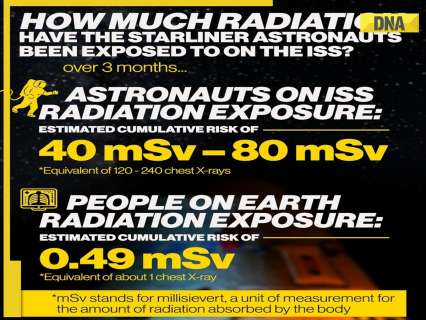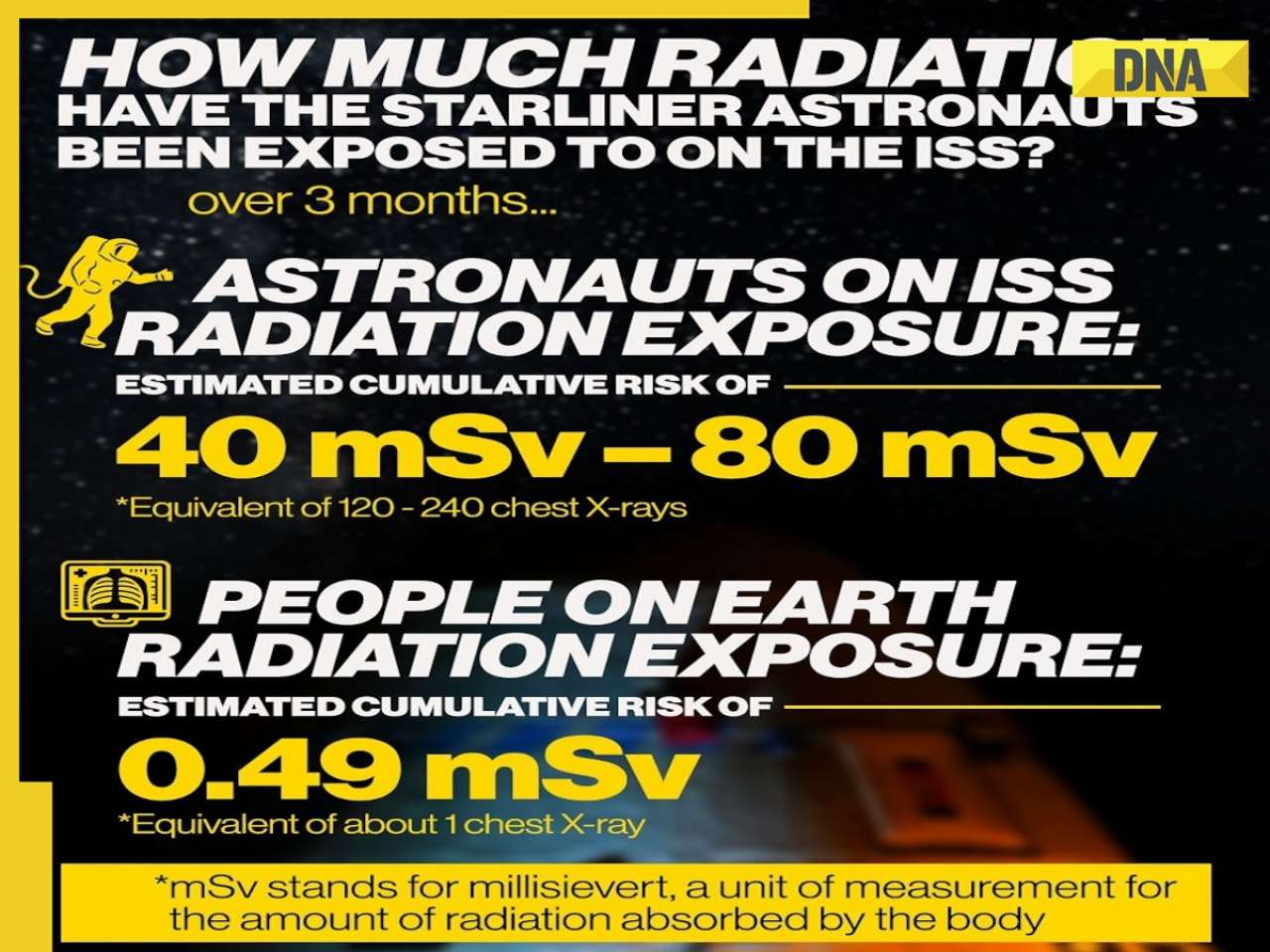
Space radiation is different from the radiation we experience on Earth. According to NASA, it consists of three types: particles trapped in Earth’s magnetic field, particles from solar flares, and galactic cosmic rays
As two NASA astronauts prepare for an unexpected, months-long stay on the International Space Station (ISS), they could also face a higher risk of radiation exposure. Barry “Butch” Wilmore and Sunita “Suni” Williams, who were part of the first crewed test flight of Boeing’s Starliner, launched on June 5. They were originally expected to stay in space for just about a week.
However, due to several issues with the spacecraft, their return has been delayed until February 2025, when they will come back aboard SpaceX’s Crew-9 Dragon spacecraft.
Space radiation is different from the radiation we experience on Earth. According to NASA, it consists of three types: particles trapped in Earth’s magnetic field, particles from solar flares, and galactic cosmic rays.
1. Particles trapped in Earth’s magnetic field : These are charged particles, mostly from the Sun, that get caught in Earth’s magnetic field, forming radiation belts around the planet.
These charged particles produce radiation when they collide with spacecraft or human tissue, potentially damaging cells and increasing health risks over time
2. Particles from solar flares : These are bursts of high-energy particles released by the Sun during solar flares, which can reach space and pose a radiation risk.
These high-energy particles from solar flares can penetrate spacecraft and human bodies, causing radiation exposure that may damage cells, DNA, and increase the risk of cancer.
3. Galactic cosmic rays : These are high-energy particles that come from outside our solar system, created by supernova explosions and other cosmic events, and can penetrate spacecraft and harm astronauts.
These extremely high-energy particles from outside the solar system can pass through spacecraft and human tissue, breaking molecular bonds and damaging cells, which may lead to long-term health problems.
Earth is protected by a magnetic field system, known as the magnetosphere, which shields us from dangerous space radiation. However, as a person goes higher in altitude, they are exposed to more radiation.
“It’s a normal increase in levels,” explained Dr. Stanton Gerson, dean of the Case Western Reserve University School of Medicine, to ABC News. “As you go higher into the atmosphere, your exposure to radiation increases.”
NASA warns that long-term exposure to space radiation puts astronauts at serious risk for radiation sickness. It also increases their lifetime chances of developing cancer, central nervous system issues, and degenerative diseases.
Degenerative issues refer to the gradual worsening of body functions, such as nerve or tissue damage, often leading to long-term health problems. Examples include Alzheimer’s disease, Parkinson’s disease , and osteoporosis , where body tissues or functions deteriorate over time.
Dr. Rihana Bokhari, acting chief scientific officer at Baylor College of Medicine’s Translational Research Institute for Space Health, explained to ABC News that astronauts on the ISS, located in low-Earth orbit, are partially shielded by Earth’s magnetosphere, which helps protect them from the intense radiation found in deep space.
However, she added that astronauts on the ISS are exposed to more radiation than people on Earth because the station passes through areas of trapped radiation during its orbit.
Butch and Suni, while on the ISS, won’t be exposed to enough radiation to cause serious damage to their bodies. However, being exposed to higher radiation levels for a long time, compared to Earth, could still increase their risk of developing cancer.
According to a 2017 NASA report, astronauts on the ISS typically receive between 80 mSv and 160 mSv of radiation during a six-month mission.
Millisieverts (mSv) are units used to measure the amount of radiation absorbed by the body.
● A single CT scan typically exposes a person to about 1 to 10 millisieverts (mSv) of radiation, depending on the type of scan and the area being examined. For example, a chest CT scan might expose you to around 7 mSv , while a head CT scan is usually closer to 2 mSv .
● A single chest X-ray typically exposes a person to about 0.1 millisieverts (mSv) of radiation. This is a relatively low dose compared to other medical imaging procedures like CT scans.
● On Earth, the average person is exposed to about 2 to 3 millisieverts (mSv) of natural background radiation over the course of 6 months. This comes from sources like the sun, the ground, and everyday materials.
Radiation Exposure and Health Risks
– 100 to 500 mSv : Increased risk of cancer over time. No immediate symptoms, but long-term exposure raises cancer risk.
– 500 to 1,000 mSv (1 Sv) : May cause nausea and other immediate symptoms. Long-term cancer risk increases.
– 1,000 to 2,000 mSv (1-2 Sv) : Can result in radiation sickness, with symptoms like nausea and vomiting. Long-term cancer risk is significant.
– Above 2,000 mSv (2 Sv) : Likely to cause severe radiation sickness and serious health problems, including tissue damage.
– 5,000 mSv (5 Sv) : Often fatal within a month without treatment.
Managing Space Radiation Exposure Risks
Gerson explained that it’s reasonable to reduce NASA’s estimates by half. For a three-month stay, astronauts face an average radiation exposure of 40 mSv to 80 mSv.
However, he added that it’s more difficult to predict sudden risks from things like solar flares.
There are spike risks due to sudden bursts of solar radiation and deep space radiation that pass through Earth’s magnetic field. Luckily, Earth’s strong magnetic field blocks most of this radiation. However, if you’re on the far side of the Moon, you don’t have that protection, Gerson explained.
Gerson added that NASA has done a great job of monitoring astronauts after they return to Earth. The agency and other researchers have learned more about how radiation impacts the body and what symptoms to watch for.
(The author of this article is a Defence, Aerospace & Political Analyst based in Bengaluru. He is also Director of ADD Engineering Components, India, Pvt. Ltd, a subsidiary of ADD Engineering GmbH, Germany. You can reach him at: girishlinganna@gmail.com)
(Disclaimer: The views expressed above are the author’s own and do not reflect those of DNA)
